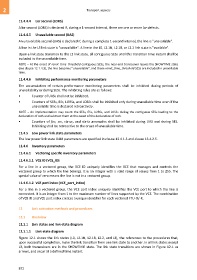Page 882 - 5G Basics - Core Network Aspects
P. 882
2 Transport aspects
11.4.4.4 Lor second (LORS)
A lor second (LORS) is declared if, during a 1-second interval, there are one or more lor defects.
11.4.4.5 Unavailable second (UAS)
An unavailable second (UAS) is declared if, during a complete 1-second interval, the line is "unavailable".
A line in the L3 link state is "unavailable". A line in the L0, L2.1N, L2.1B, or L2.2 link state is "available".
Upon a link state transition to the L3 link state, all contiguous SESs until this transition time instant shall be
included in the unavailable time.
NOTE – At the onset of reinit_time_threshold contiguous SESs, the near-end transceiver leaves the SHOWTIME state
(see clause 12.1.4.3), the line becomes "unavailable", and these reinit_time_threshold SESs are included in unavailable
time.
11.4.4.6 Inhibiting performance monitoring parameters
The accumulation of certain performance monitoring parameters shall be inhibited during periods of
unavailability or during SESs. The inhibiting rules are as follows:
• Counter of UASs shall not be inhibited.
• Counters of SESs, ESs, LORSs, and LOSSs shall be inhibited only during unavailable time even if the
unavailable time is declared retroactively.
NOTE – An implementation may count the SESs, ESs, LORSs, and LOSSs during the contiguous SESs leading to the
declaration of UAS and subtract them at the onset of the declaration of UAS.
• Counters of fec, crc, rtx-uc, and rtx-tx anomalies shall be inhibited during UAS and during SES.
Inhibiting shall be retroactive to the onset of unavailable time.
11.4.5 Low power link state parameters
The low power link state OAM parameters are specified in clause 13.4.1.5 and clause 13.4.2.5.
11.4.6 Inventory parameters
11.4.6.1 Vectoring specific inventory parameters
11.4.6.1.1 VCE ID (VCE_ID)
For a line in a vectored group, the VCE ID uniquely identifies the VCE that manages and controls the
vectored group to which the line belongs. It is an integer with a valid range of values from 1 to 255. The
special value of zero means the line is not in a vectored group.
11.4.6.1.2 VCE port index (VCE_port_index)
For a line in a vectored group, the VCE port index uniquely identifies the VCE port to which the line is
connected. It is an integer from 1 to the maximum number of lines supported by the VCE. The combination
of VCE ID and VCE port index creates a unique identifier for each vectored FTU-O/-R.
12 Link activation methods and procedures
12.1 Overview
12.1.1 Link states and link-state diagram
12.1.1.1 Link-state diagram
Figure 12-1 shows the link states (L0, L2.1N, L2.1B, L2.2, and L3), the references to the procedures that,
upon successful completion, make the link transition from one link state to another. In all link states except
L3, both transceivers are in the SHOWTIME state. The link state transitions are shown in Figure 12-1 as
arrows, and occur at a defined time instant.
872

